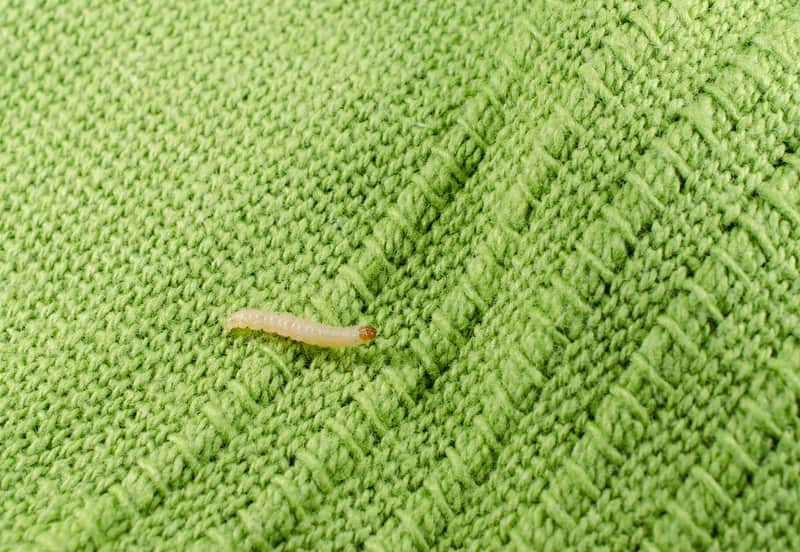It’s no fun reaching into your closest for a favorite sweater, suit or dress only to find the garment has been attacked by moths. These tiny insects are both stealthy and hungry, and they love to spend time in places where your clothes are waiting.

Where do clothes moths come from and why are they so intent on ruining your wardrobe? It’s not personal. It’s just their nature.
Types of clothes-eating moths
There are two types of moths that typically invade our closets, the webbing clothes moth (Tineola bisselliella) and the casemaking clothes moth (Tinea pellionella). Each is less than an inch in size. The webbing clothes moth is uniform in color while the casemaking clothes moth has dark specks on its wings. These moths are so small that you may not notice you have an infestation until clothing, bedding, floor coverings or stored items are damaged, or until you see a lot of flying adults.
Clothes-eating moths are different from the food-infesting moths you may see fluttering in your pantry or kitchen. Food moths can be double the size of clothes moths, and you can also spot the difference by examining their heads under a magnifying glass. Food moths are bald, while clothes moths often have tiny tufts of hair.
The life cycle of clothes moths
Adult clothes moths don't have functional mouthparts and cannot damage your possessions. Their hungry offspring are the real culprits.
After mating, the female moth can lay up to 300 eggs before dying. Moth eggs hatch in four to 10 days during the summer but may take several weeks to hatch in the winter. The male moths live on for about a month to mate with other females, creating hundreds more of these tiny starving pests.
The moth larva begins feeding right after hatching from the egg. There are multiple larval stages which get progressively bigger through molting. The development time can vary from one month to three depending on food source and room temperature.
When the larvae of the casemaking moth are ready to pupate — beginning the process by which they develop into adult moths — they move up and attach themselves to a surface with a silk thread from which the pupa hangs. This is one way pest control service technicians know which species they are dealing with if they cannot find adults.
Pupation for webbing clothes moth larvae occurs inside a silken cocoon, which is usually found in places where the larvae have been feeding. Finding one of these cocoons in a drawer, closet or storage area is a sure sign of possible moth infestation.
The damage clothes moths can do
The larvae of both clothes moth species will feed on and potentially damage a variety of household items that have keratin (which they need to develop), including the following:
- Items made with animal fur or animal byproducts, such as silk, leather or wool
- Upholstered furniture and draperies
- Synthetic fabrics or cotton fabric blends that contain wool
- Dirty clothing, especially items that retain moisture from spilled liquids
- Items made from animal hair or that contain either human or pet hair
Damage to clothing often appears in hidden locations, such as under collars or cuffs. Damage to linens and fabrics may not be noticeable until a hole appears. Larvae can also feed on stray hair or clothing strands that become trapped in baseboards, under rugs or around furniture.
Planning for how to prevent clothes moths in closets — as well as other places where clothes and fabrics are stored — is the key to helping keep your precious items safe.
How to help prevent clothes moths in closets
Clothes moths can find their way to your closet through many different means. They can catch a ride on second-hand goods, whether it’s thrift store clothing, a consignment shop couch or a garage sale blanket. They also travel by way of items kept in storage spaces, sheds or garages, and through small cracks and crevices in the home. They can even just fly in through an open door or window or a damaged screen.
Regardless of how they arrive, there are a number of ways to help protect your clothing and other items from clothes moths. Cornell University’s Insect Diagnostic Laboratory offers these tips:
- Thoroughly inspect vulnerable clothes, fabrics and stored items at least once a year for moth larvae and damage. Consider discarding damaged items if it is difficult to repair them satisfactorily.
- Check areas around the home where moths may hide, looking for signs of infestation. Remove items from closets and drawers and vacuum thoroughly, trapping the lint on which larvae can feed.
- Clean regularly to help prevent lint, dust or hair from accumulating. Vacuum rugs and carpets, drapes, upholstered furniture and pet bedding. Vacuum under furniture that is seldom moved and along baseboards where wool lint might accumulate.
- Vacuum inside closets, around water heaters and other appliances, near air vents and ducts and in cracks and crevices along floors.
- Clean clothing and other fabrics thoroughly before storing them, especially if you will do so for a long period. Place items in secure plastic bags or airtight containers.
- When shopping for woolens or wool blends, consider buying items that the manufacturer has treated with a moth-resistant compound. Professional cleaners may also be able to add mothproofing to certain items.
Contrary to popular belief, cedar chests are not the best remedy for clothes moths. If you’re tired of moths munching on your wardrobe but can’t quite get rid of them, perhaps it’s time to call a professional. The pest control specialists at Terminix® will work with you to make sure those eager insects can no longer raid your closet.



